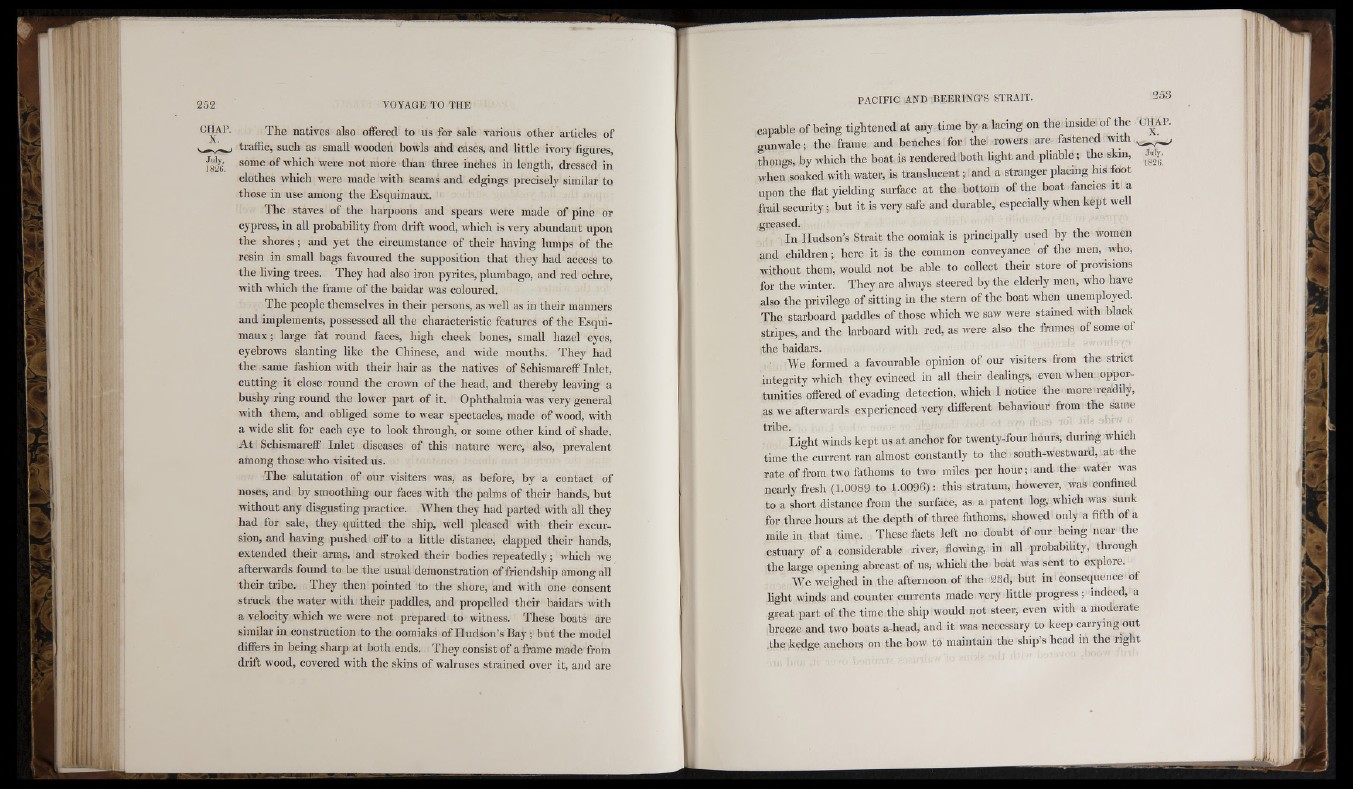
Il
The natives also offered to ns for sale varions other articles of
traffic, snch as small wooden bowls and cases, and little ivory figures,
some of which were not more than three inches in length, dressed in
clothes which were made with seams and edgings precisely similar to
those in use among the Esquimaux.
The staves of the harpoons and spears were made of pine or
cypress, in all probability from drift wood, which is very abundant upon
the shores; and yet the circumstance of their having lumps of the
resin in small bags favoured the supposition that they had access to
the living trees. They had also iron pyrites, plumbago, and red ochre,
with which the frame of the baidar was coloured.
The people themselves in their persons, as well as in their manners
and implements, possessed all the characteristic features of the Esquimaux
; large fat round faces, high cheek bones, small hazel eyes,
eyebrows slanting like the Chinese, and wide mouths. They had
the same fashion with their hair as the natives of Schismareff Inlet,
cutting it close round the crown of the head, and thereby leaving a
bushy ring round the lower part of it. Ophthalmia was very general
with them, and obliged some to wear spectacles, made of wood, with
a wide slit for each eye to look through, or some other kind of shade.
At Schismareff Inlet diseases of this nature were, also, prevalent
among those who visited us.
The salutation of our visiters was, as before, by a contact of
noses, and by smoothing our faces with the palms of their hands, but
without any disgusting practice. When they had parted with all they
had for sale, they quitted the ship, well pleased with their excursion,
and having pushed off to a little distance, clapped their hands,
extended their arms, and stroked their bodies repeatedly; which we
afterwards found to be the usual demonstration of friendship among all
their tribe. They then pointed to the shore, and with one consent
struck the water with their paddles, and propelled their baidars with
a velocity which we were not prepared to witness. These boats are
similar in construction to the oomiaks of Hudson’s Bay ; but the model
differs in being sharp at both ends. They consist of a frame made from
drift wood, covered with the skins of walruses strained over it, and are
capable of being tightened at any time by a lacing on the inside of the CHAP.
gunwale; the frame and benches for the rowers are fastened with ,
thongs, by which the boat is rendered both light and pliable; the skin,
when soaked with water, is translucent; and a stranger placing his foot
upon the flat yielding surface at the bottom of the boat fancies it a
frail security; but it is very safe and durable, especially when kept well
greased.
In Hudson’s Strait the oomiak is principally used by the women
and children; here it is the common conveyance of the men, who,
without them, would not be able to collect their store of provisions
for the winter. They are always steered by the elderly men, who have
also the privilege of sitting in the stern of the boat when unemployed.
The starboard paddles of those which we saw were stained with black
stripes, and the larboard with red, as were also the frames of some of
the baidars.
■ We formed a favourable opinion of our visiters from the strict
integrity which they evinced in all their dealings, even when opportunities
offered of evading detection, which I notice the more readily,
as we afterwards experienced very different behaviour from the same
tribe.
Light winds kept us at anchor for twenty-four hours, during which
time the current ran almost constantly to the south-westward, at the
rate of from two fathoms to two miles per hour; and the water was
nearly fresh (1.0089 to 1.0096): this stratum, how'ever, was confined
to a short distance from the surface, as a patent log, which was sunk
for three hours at the depth of three fathoms, showed only a fifth of a
mile in that time. These facts left no doubt of our being near the
estuary of a considerable river, flow'ing, in all probability, through
the large opening abreast of us, which the boat was sent to explore.
W e weighed in th e afternoon of th e 2Sd, b u t in consequence of
lig h t w'inds and co u n te r cu rren ts made very little p ro g re s s ; indeed, a
g re a t p a rt o f th e time th e ship would n o t steer, even with a moderate
breeze a n d two boats a-head, and it was necessary to keep carrying o u t
th e kedge anchors on th e bow to maintain th e ship’s h e ad in th e rig h t